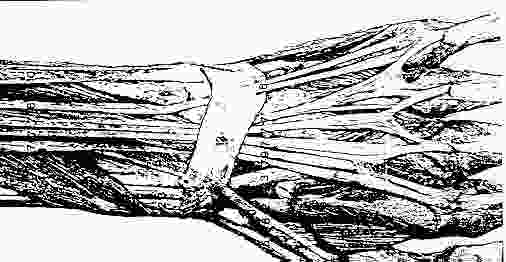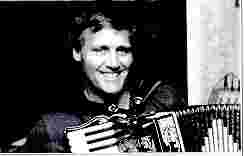
Note the wide "watch strap" band of tissue that retains the muscle tendons.
 Have you over noticed from watching other people play the accordion that
some can make the most intricate and demanding passages look effortless?
The proficient player has a relaxed manner, with hands seemingly
motionless yet clearly articulates notes with little apparent effort.
Conversely, some look as though they are wrestling with alligators and
appear to fight their instruments to achieve their objective.
Have you over noticed from watching other people play the accordion that
some can make the most intricate and demanding passages look effortless?
The proficient player has a relaxed manner, with hands seemingly
motionless yet clearly articulates notes with little apparent effort.
Conversely, some look as though they are wrestling with alligators and
appear to fight their instruments to achieve their objective. This writer recently had the good fortune to see and hear Galla-Rini protege Jorgan Sundeqvist of Sweden when he played at a concert in Portland. I was very impressed with the apparent effortlessness of his execution, even in the most dynamic and demanding pieces like the complete Espana Rhapsody, by Chabrier. I say apparent, because I had the opportunity to visit with Jorgan backstage during the performance, and it was clearly evident that he worked extremely hard at his craft and generated considerable energy and heat in managing his specially made Petosa Bayan accordion, which is larger and heavier, due to its extended keyboard and extra bass and treble reeds.
During the second half, I sat back and watched, as a medical professional, how this master musician physically handled his instrument and tried to determine just how he made it appear so easy and effortless. Immediately apparent was his playing posture. He chose his seat height very carefully. An adjustable piano bench enabled him to sit so that his hips and knees were very nearly at right angles to each other. The instrument, large as it was, looked part of his chest, close in and high up so that his chin was within an inch or so above the right hand keyboard. The accordion was adjusted laterally so that a vertical line down from Jorgen's nose fell just at the outer end of the black keys. The accordion keyboard was kept near vertical at all times. Jorgen's posture was upright, relaxed, and poised slightly forward. It appeared to me that he was working over the keyboard and not laying back from it. Most notable was the constant uniform position of his shoulder, forearm, wrist, and fingers. Here I would use the descriptive word "quiet", meaning relaxed, fluid, and flowing. Jorgen's elbow remained comfortably away from his body, and the angle between his wrist and his forearm was seldom more than 10 degrees. Playing posture was always perfectly balanced, energy efficient, and alert but relaxed, which explains how this dynamic and talented player could perform a two hour concert without exhausting himself. Which brings me to the main part of this discussion.
In my profession, one of my tasks is to analyze why a patient is hurt repeatedly by doing certain functions and what can be done to avoid injury and improve the mechanics of that function while maximizing energy efficiency. Having spent many years observing proficient (and not so proficient) players handle their instruments, I believe that perhaps the single most important impediment to the execution of fast or difficult passages is the angle that the wrist makes with the forearm. My reasoning is anatomically based upon the fact that to function efficiently and maximize performance, a muscle contracts and relaxes best when it is in its natural configuration and at its natural (non-stretched or non-contracted) length. This may sound a little complicated, so perhaps some basic anatomical concepts will help the reader grasp what I am talking about.
You have all seen players (or perhaps you are one of these ! ) who tend to keep the right elbow tucked into the body and maintains a near 90 degree angle between wrist and forearm. This anatomically unnatural position makes playing efficiently impossible and is very tiring to the muscles needed to lift up and put down individual fingers on the treble keys.
Most of you will be aware that the muscles that enable you to depress a key and release it are two entirely different muscle group entities. The muscles which cause the key depression are called flexor muscles and are found on the inner forearm, starting at a point close to your funny bone at the elbow. These muscles run down the forearm, pass under a ligament band at the wrist not unlike a watch strap, and then branch out as tendons to each of your fingers, with your thumb receiving special additional muscles to allow for its specialized movement. Actually, there are two separate muscles in the fingers which accomplish hitting the note, each coordinating with the other. To further complicate things, the fifth finger has an additional flexor muscle not common to the other three fingers, while the thumb, which I mentioned, has additional short muscles which are important in allowing it to participate in such things as fingering a scale sequence, i.e.: 1-2-3-1-2-3-4-5. The thumb is passed under the third finger making use of a little muscle called adducter pollicus.
Lifting the finger from a note is carried out principally by the extensor muscles, mainly the extensor communis digitorum (which is simply Latin for the common finger extensor.) There are also short extensor wrist muscles which assist the long extensors. It is logical, therefore, that both flexor and extensor groups should work most efficiently (quickly) if the muscles are nearly in a straight line from elbow to fingertip, ie. with little bend in the wrist.
Try this experiment on yourself to prove my point. Put your accordion on and with your elbow comfortably away from your side, and with the back of your wrist and forearm in a near straight line with only a few degrees of bend, perform a quick trill with fingers two and three as fast as you can. Now, pull your elbow into your side, bend your wrist inward towards the keyboard, and try the trill again. Notice how it is impossible to move as quickly? Notice also that the greater the angle between your forearm and your wrist, the slower your fingers move. Now cock your wrist backwards as far as it will go and try the trill in the air. The same thing happens - the fingers will just not move as quickly.
The reason for this is twofold. As I mentioned before, a muscle contracts and relaxes most efficiently if it is in a straight line, but perhaps more importantly, the greatest impediment to that efficiency is caused by a band of ligamentous tissue called the flexer retinaculum, which runs across your inner wrist like a watch band, situated at a point where your hand joins your wrist. There is a similar band of tissue across the back of the wrist called the extensor retinaculum. Both these ligamentous bands serve the purpose of preventing the muscle tendons from springing away from the wrist when you bend or extend your wrist. (See wrist diagram below.) If the wrist is not nearly in line with the forearm, the extensor and flexor tendons will be impeded by the bands on the front and back of your wrist.
The muscular mechanism of the hand is much more complicated and involves a lot more factors than I have mentioned above, but my simple example serves the purpose of describing broadly just why it is important to have a correct shoulder, forearm and hand position with relation to the right hand keyboard. The key to achieving this is quite simple. With your elbow comfortably away from your side, it is easy to play with a near straight wrist. While it may feel a little awkward at first, this position definitely prevents your wrist from slowing down your fingers. We have a demanding enough instrument to balance and control - why make it more difficult? In a future issue I shall address the left hand position and its mechanics. Please feel free to write to me care of Accordion World if you have any concerns or questions on the above.

Note the wide "watch strap" band of tissue that retains the muscle
tendons.
Reprinted from Accordion World, (Portland, Oregon: June 1994). Used with permission.
The Classical Free-Reed, Inc. staff gratefully acknowledges
volunteer Terry Knight who assisted in the production of this
article.
Born in New Zealand in 1942 of Italian parents, he grew up in a musical
family in which his grandfather played accordion. Mr. Bonica played
drums, percussion, flugelhorn, bugle and string bass before turning to the
accordion at age 15. He taught himself by ear and learned the Chopin
"Minute Waltz" by listening to a recording by Charles Magnante.
After some time, he realized the limitations of playing only by ear, so he
taught himself how to read music so he could enter competitions. He won
the New Zealand Championship several years in the duet, trio and quartet
divisions. He won second place at the New Zealand Open in 1978 in the solo
division.
Mr. Bonica emigrated to the United States in 1980 to teach spinal
specialists and continue his practice of spinal therapy. He has recorded
four CDs of Italian and European folk music utilizing a MIDI orchestra
ensemble. Other activities include writing and publishing (he was editor
and publisher for Accordion World magazine from 1989 until 1994),
sailing and photography.
Part Five: Oh,
My Aching Neck and Shoulders!
An Exercise Program
That May Help!
by John Bonica, L.P.T.,
N.Z.R.P. Part Six:
Special Instructions for Low Back Patients
by
John Bonica, L.P.T., N.Z.R.P.Part Seven: The
Great Accordion Myth!
Is Lighter Really
Better?
by John Bonica, L.P.T.,
N.Z.R.P.
Invitation to Contributors / Submission
Guidelines Back to The Free-Reed Journal
Contents Page Back to The Classical Free-Reed,
Inc. Home Page